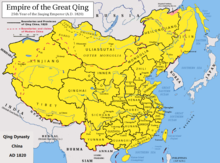
Back Dinastie Afrikaans Dynastie ALS سلالة حاكمة Arabic Xanədan Azerbaijani خاندان AZB Династия Bashkir Dynastie BAR Dinastiya BCL Дынастыя Byelorussian Династия Bulgarian
| Part of the Politics series |
| Politics |
|---|
|
|


A dynasty is a sequence of rulers from the same family,[1] usually in the context of a monarchical system, but sometimes also appearing in republics. A dynasty may also be referred to as a "house", "family" or "clan", among others.
Historians periodize the histories of many states and civilizations, such as Ancient Iran (3200 – 539 BC), Ancient Egypt (3100 – 30 BC), and Ancient and Imperial China (2070 BC – AD 1912), using a framework of successive dynasties. As such, the term "dynasty" may be used to delimit the era during which a family reigned.
Before the 18th century, most dynasties throughout the world have traditionally been reckoned patrilineally, such as those that follow the Frankish Salic law. In polities where it was permitted, succession through a daughter usually established a new dynasty in her husband's family name. This has changed in all of Europe's remaining monarchies, where succession law and conventions have maintained dynastic names de jure through a female.
Dynastic politics has declined over time, owing to a decline in monarchy as a form of government, a rise in democracy, and a reduction within democracies of elected members from dynastic families.[2]
- ^ Oxford English Dictionary, 1st ed. "dynasty, n." Oxford University Press (Oxford), 1897.
- ^ Van Coppennolle, Brenda; Smith, Daniel (2023). "Dynasties in Historical Political Economy" (PDF). The Oxford Handbook of Historical Political Economy. Archived (PDF) from the original on 20 September 2023. Retrieved 21 August 2022.
© MMXXIII Rich X Search. We shall prevail. All rights reserved. Rich X Search